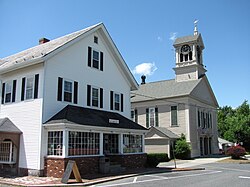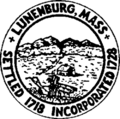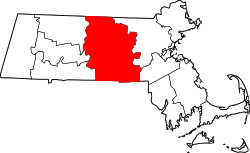Geography
According to the United States Census Bureau, the town has a total area of 27.7 square miles (72 km2), of which 26.4 square miles (68 km2) is land and 1.3 square miles (3.4 km2), or 4.59%, is water.
Lunenburg is bordered by Townsend to the north, Shirley to the east, Lancaster to the southeast, Leominster to the south, Fitchburg to the west, and Ashby to the northwest. Three state highways pass through Lunenburg. Route 2A follows Mass Ave from the Shirley line to the Fitchburg line. Rt 13 follows Electric Ave from the Leominster line to Mass Ave. Rt 13 then follows Mass Ave/Rt 2a for 0.3 miles. Rt 13 then follows Chase Rd to the Townsend Line. Rt 225 begins in Lunenburg, at an intersection with Rt 2a/Mass Ave near the Shirley line. Rt 225 follows West Groton Rd from Rt 2a to the Shirley line.
Demographics
Historical population| Year | | |
|---|
| 1900 | 1,332 | — |
|---|
| 1910 | 1,393 | +4.6% |
|---|
| 1920 | 1,634 | +17.3% |
|---|
| 1930 | 1,923 | +17.7% |
|---|
| 1940 | 2,195 | +14.1% |
|---|
| 1950 | 3,906 | +77.9% |
|---|
| 1960 | 6,334 | +62.2% |
|---|
| 1970 | 7,419 | +17.1% |
|---|
| 1980 | 8,405 | +13.3% |
|---|
| 1990 | 9,117 | +8.5% |
|---|
| 2000 | 9,401 | +3.1% |
|---|
| 2010 | 10,086 | +7.3% |
|---|
| 2020 | 11,782 | +16.8% |
|---|
| 2024* | 12,007 | +1.9% |
|---|
* = population estimate.
Source: United States census records and Population Estimates Program data. [4] [5] [6] [7] [8] [9] [10] [11] [12] [13] [14] |
As of the census [15] of 2000, there were 9,401 people, 3,535 households, and 2,668 families residing in the town. The population density was 355.8 inhabitants per square mile (137.4/km2). There were 3,668 housing units at an average density of 138.8 per square mile (53.6/km2). The racial makeup of the town was 97.01% White, 0.69% Black or African American, 0.20% Native American, 0.78% Asian, 0.02% Pacific Islander, 0.26% from other races, and 1.04% from two or more races. Hispanic or Latino of any race were 1.15% of the population.
There were 3,535 households, out of which 34.9% had children under the age of 18 living with them, 63.6% were married couples living together, 8.7% had a female householder with no husband present, and 24.5% were non-families. 20.1% of all households were made up of individuals, and 8.3% had someone living alone who was 65 years of age or older. The average household size was 2.66 and the average family size was 3.08.
In the town, the population was spread out, with 25.8% under the age of 18, 5.6% from 18 to 24, 29.8% from 25 to 44, 26.8% from 45 to 64, and 12.0% who were 65 years of age or older. The median age was 39 years. For every 100 females, there were 98.1 males. For every 100 females age 18 and over, there were 95.3 males.
The median income for a household in the town was $56,813, and the median income for a family was $63,981. Males had a median income of $47,451 versus $31,934 for females. The per capita income for the town was $26,986. About 3.3% of families and 4.1% of the population were below the poverty line, including 3.7% of those under age 18 and 1.4% of those age 65 or over.
Education
The public schools in town are the Lunenburg Primary School, Turkey Hill Elementary School, and Lunenburg Middle-High School. The high and middle schools are in the same building, beside the Turkey Hill building.
Private schools include Applewild School, an independent coeducational day school for pre-schoolers to eighth graders, established in 1957 in Fitchburg.
Montachusett Regional Vocational Technical High School serves Lunenburg and Fitchburg.
This page is based on this
Wikipedia article Text is available under the
CC BY-SA 4.0 license; additional terms may apply.
Images, videos and audio are available under their respective licenses.





